建筑英语--诺曼福斯特 德国法兰克福商业银行大厦浅析
- 格式:doc
- 大小:447.50 KB
- 文档页数:8

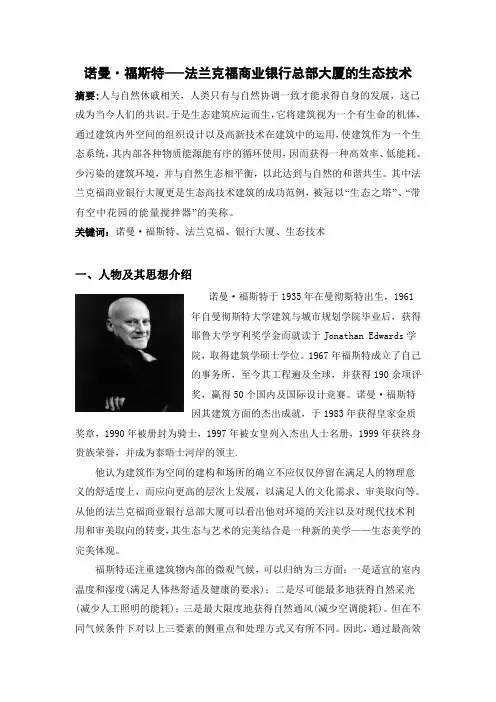
诺曼·福斯特---法兰克福商业银行总部大厦的生态技术摘要:人与自然休戚相关,人类只有与自然协调一致才能求得自身的发展,这已成为当今人们的共识。
于是生态建筑应运而生,它将建筑视为一个有生命的机体,通过建筑内外空间的组织设计以及高新技术在建筑中的运用,使建筑作为一个生态系统,其内部各种物质能源能有序的循环使用,因而获得一种高效率、低能耗、少污染的建筑环境,并与自然生态相平衡,以此达到与自然的和谐共生。
其中法兰克福商业银行大厦更是生态高技术建筑的成功范例,被冠以“生态之塔”、“带有空中花园的能量搅拌器”的美称。
关键词:诺曼·福斯特、法兰克福、银行大厦、生态技术一、人物及其思想介绍诺曼·福斯特于1935年在曼彻斯特出生,1961年自曼彻斯特大学建筑与城市规划学院毕业后,获得耶鲁大学亨利奖学金而就读于Jonathan Edwards学院,取得建筑学硕士学位。
1967年福斯特成立了自己的事务所,至今其工程遍及全球,并获得190余项评奖,赢得50个国内及国际设计竞赛。
诺曼·福斯特因其建筑方面的杰出成就,于1983年获得皇家金质奖章,1990年被册封为骑士,1997年被女皇列入杰出人士名册,1999年获终身贵族荣誉,并成为泰晤士河岸的领主.他认为建筑作为空间的建构和场所的确立不应仅仅停留在满足人的物理意义的舒适度上,而应向更高的层次上发展,以满足人的文化需求、审美取向等。
从他的法兰克福商业银行总部大厦可以看出他对环境的关注以及对现代技术利用和审美取向的转变,其生态与艺术的完美结合是一种新的美学——生态美学的完美体现。
福斯特还注重建筑物内部的微观气候,可以归纳为三方面:一是适宜的室内温度和湿度(满足人体热舒适及健康的要求);二是尽可能最多地获得自然采光(减少人工照明的能耗);三是最大限度地获得自然通风(减少空调能耗)。
但在不同气候条件下对以上三要素的侧重点和处理方式又有所不同。

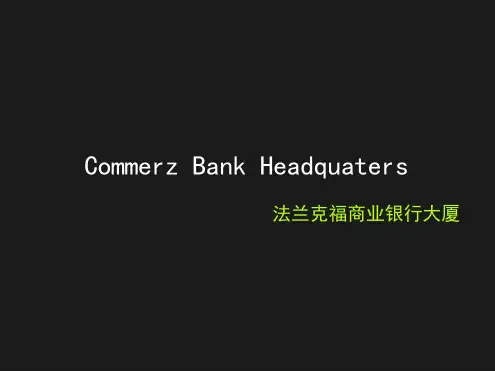
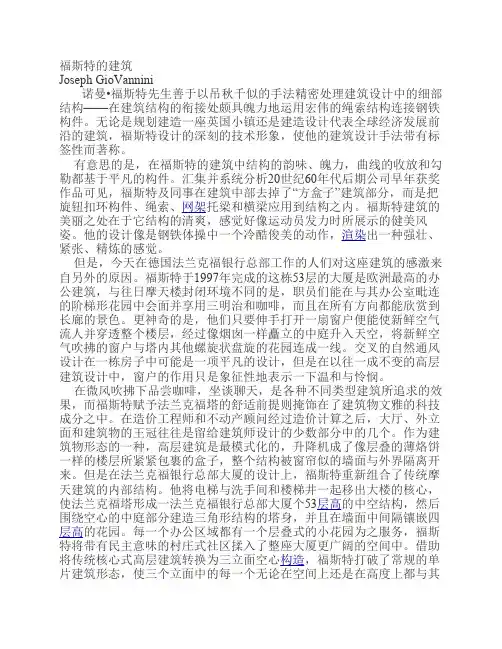
福斯特的建筑Joseph GioVannini诺曼•福斯特先生善于以吊秋千似的手法精密处理建筑设计中的细部结构——在建筑结构的衔接处颇具魄力地运用宏伟的绳索结构连接钢铁构件。
无论是规划建造一座英国小镇还是建造设计代表全球经济发展前沿的建筑,福斯特设计的深刻的技术形象,使他的建筑设计手法带有标签性而著称。
有意思的是,在福斯特的建筑中结构的韵味、魄力,曲线的收放和勾勒都基于平凡的构件。
汇集并系统分析20世纪60年代后期公司早年获奖作品可见,福斯特及同事在建筑中部去掉了“方盒子”建筑部分,而是把旋钮扣环构件、绳索、网架托梁和横梁应用到结构之内。
福斯特建筑的美丽之处在于它结构的清爽,感觉好像运动员发力时所展示的健美风姿。
他的设计像是钢铁体操中一个冷酷俊美的动作,渲染出一种强壮、紧张、精炼的感觉。
但是,今天在德国法兰克福银行总部工作的人们对这座建筑的感激来自另外的原因。
福斯特于1997年完成的这栋53层的大厦是欧洲最高的办公建筑,与往日摩天楼封闭环境不同的是,职员们能在与其办公室毗连的阶梯形花园中会面并享用三明治和咖啡,而且在所有方向都能欣赏到长廊的景色。
更神奇的是,他们只要伸手打开一扇窗户便能使新鲜空气流人并穿透整个楼层,经过像烟囱一样矗立的中庭升入天空,将新鲜空气吹拂的窗户与塔内其他螺旋状盘旋的花园连成一线。
交叉的自然通风设计在一栋房子中可能是一项平凡的设计,但是在以往一成不变的高层建筑设计中,窗户的作用只是象征性地表示一下温和与怜悯。
在微风吹拂下品尝咖啡,坐谈聊天,是各种不同类型建筑所追求的效果,而福斯特赋予法兰克福塔的舒适前提则掩饰在了建筑物文雅的科技成分之中。
在造价工程师和不动产顾问经过造价计算之后,大厅、外立面和建筑物的王冠往往是留给建筑师设计的少数部分中的几个。
作为建筑物形态的一种,高层建筑是最模式化的,升降机成了像层叠的薄烙饼一样的楼层所紧紧包裹的盒子,整个结构被窗帘似的墙面与外界隔离开来。

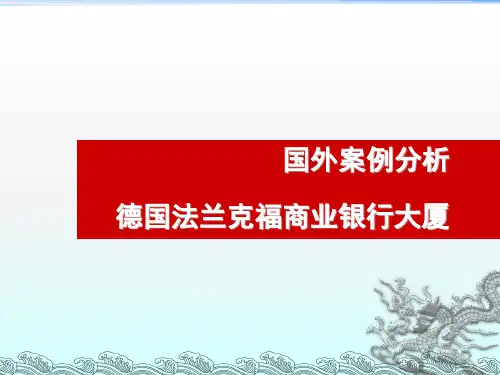
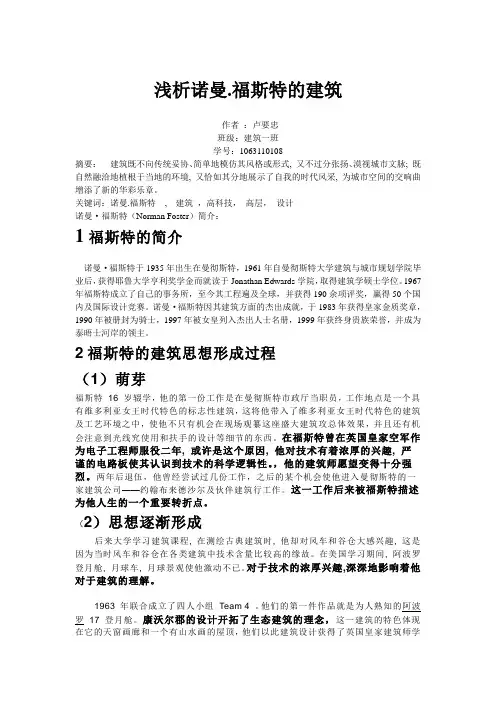
浅析诺曼.福斯特的建筑作者:卢要忠班级:建筑一班学号:1063110108摘要:建筑既不向传统妥协、简单地模仿其风格或形式, 又不过分张扬、漠视城市文脉; 既自然融洽地植根于当地的环境, 又恰如其分地展示了自我的时代风采, 为城市空间的交响曲增添了新的华彩乐章。
关键词:诺曼.福斯特, 建筑,高科技,高层,设计诺曼·福斯特(Norman Foster)简介:1福斯特的简介诺曼·福斯特于1935年出生在曼彻斯特,1961年自曼彻斯特大学建筑与城市规划学院毕业后,获得耶鲁大学亨利奖学金而就读于Jonathan Edwards学院,取得建筑学硕士学位。
1967年福斯特成立了自己的事务所,至今其工程遍及全球,并获得190余项评奖,赢得50个国内及国际设计竞赛。
诺曼·福斯特因其建筑方面的杰出成就,于1983年获得皇家金质奖章,1990年被册封为骑士,1997年被女皇列入杰出人士名册,1999年获终身贵族荣誉,并成为泰晤士河岸的领主。
2福斯特的建筑思想形成过程(1)萌芽福斯特16 岁辍学,他的第一份工作是在曼彻斯特市政厅当职员,工作地点是一个具有维多利亚女王时代特色的标志性建筑,这将他带入了维多利亚女王时代特色的建筑及工艺环境之中,使他不只有机会在现场观纂这座盛大建筑攻总体效果,并且还有机会注意到光线究使用和扶手的设计等细节的东西。
在福斯特曾在英国皇家空军作为电子工程师服役二年, 或许是这个原因, 他对技术有着浓厚的兴趣, 严谨的电路板使其认识到技术的科学逻辑性。
,他的建筑师愿望变得十分强烈。
两年后退伍,他曾经尝试过几份工作,之后的某个机会使他进入曼彻斯特的一家建筑公司——约翰布来德沙尔及伙伴建筑行工作。
这一工作后来被福斯特描述为他人生的一个重要转折点。
(2)思想逐渐形成后来大学学习建筑课程, 在测绘古典建筑时, 他却对风车和谷仓大感兴趣, 这是因为当时风车和谷仓在各类建筑中技术含量比较高的缘故。
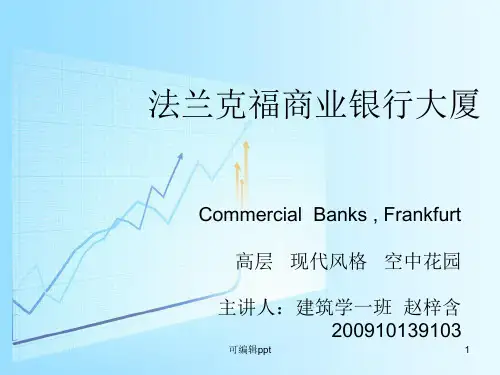

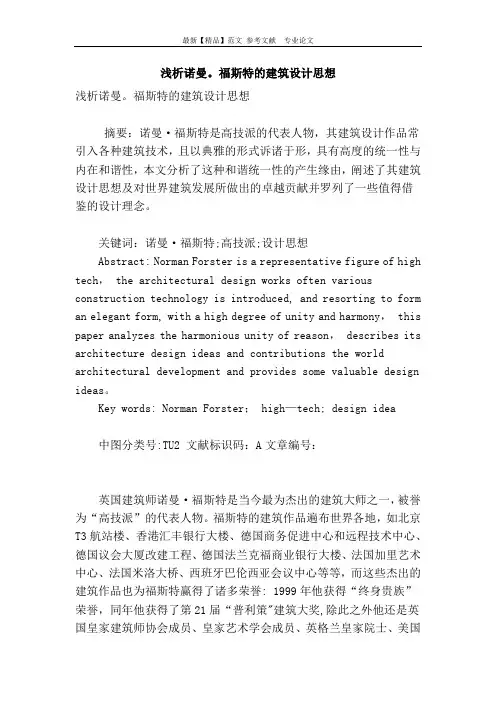
浅析诺曼。
福斯特的建筑设计思想浅析诺曼。
福斯特的建筑设计思想摘要:诺曼·福斯特是高技派的代表人物,其建筑设计作品常引入各种建筑技术,且以典雅的形式诉诸于形,具有高度的统一性与内在和谐性,本文分析了这种和谐统一性的产生缘由,阐述了其建筑设计思想及对世界建筑发展所做出的卓越贡献并罗列了一些值得借鉴的设计理念。
关键词:诺曼·福斯特;高技派;设计思想Abstract: Norman Forster is a representative figure of high tech, the architectural design works often various construction technology is introduced, and resorting to form an elegant form, with a high degree of unity and harmony, this paper analyzes the harmonious unity of reason, describes its architecture design ideas and contributions the world architectural development and provides some valuable design ideas。
Key words: Norman Forster; high—tech; design idea中图分类号:TU2 文献标识码:A文章编号:英国建筑师诺曼·福斯特是当今最为杰出的建筑大师之一,被誉为“高技派”的代表人物。
福斯特的建筑作品遍布世界各地,如北京T3航站楼、香港汇丰银行大楼、德国商务促进中心和远程技术中心、德国议会大厦改建工程、德国法兰克福商业银行大楼、法国加里艺术中心、法国米洛大桥、西班牙巴伦西亚会议中心等等,而这些杰出的建筑作品也为福斯特赢得了诸多荣誉: 1999年他获得“终身贵族”荣誉,同年他获得了第21届“普利策"建筑大奖,除此之外他还是英国皇家建筑师协会成员、皇家艺术学会成员、英格兰皇家院士、美国建筑师协会名誉会员、皇家工业设计师、特许设计师协会荣誉会员。
建筑英语题目:德国法兰克福商业银行大厦浅析学院:外国语学院课程名称:建筑英语班级:英语102班姓名:李君学号:20101410772012年10月19日Analysis of Commerzbank Tower------The ecological hi-tech architectural design[Abstract] This paper briefly introduces Foster and partners‟Commerzbank reinvents the skyscraper. Foster used Eco-Tech and Hi-Tech as well as new material in his design which embodies the ideas of sustainable development. And he made the great contribution in ecological and Hi-Tech architectural design.[Key Words]Commerzbank skyscraper, ecologically environment, natural ventilation, gardens in the skyThe new headquarters for Commerzbank in Frankfurt is the world‟s tallest ecological high-rise tower. The design addressed sustainability issues such as: ambient energy used as much as possible to reduce the dependency on fossil fuels by an innovative façade and building system that uses natural ventilation; maintaining health and happiness for the users by daylighting office space and allowing them to enjoy the outdoors by operable windows and planted sky gardens; recycling gray water for cooling and sanitary purposes; and community and connection through careful scaling of relationships with street and surrounding neighborhood. The consideration of these issues reflected by the different building components will be discussed, analyzed and commented on. The Commerzbank headquarters was the first skyscraper to seriously take sustainability into consideration and to allow it to form the basis of the building‟s design; the prototype‟s success or failure will influence how …green‟ skyscrapers will be in the fu ture.Brief introductionAt fifty-three storeys, the Commerzbank is the world‟s first ecological office tower and the tallest building in Europe. The outcome of a limited international competition, the project explores the nature of the office environment, developing new ideas for its ecology and working patterns. Central to this concept is a reliance on natural systems of lighting and ventilation. Every office in the tower is daylit and has openable windows, allowing occupants to control their own environment, and resulting in energy consumption levels equivalent to half those of conventional office towers.The plan of the building is triangular, comprising three petals - the office floors - and a stem formed by a full-height central atrium. Pairs of vertical masts enclose services and circulation cores in the corners of the plan and support eight-storey Vierendeel beams, which in turn support clear-span office floors. Four-storey gardens are set at different levels on each side of the tower, forming a spiral of landscaping around the building, and visually establishing a social focus for village-like offices clusters. These gardens play an ecological role, bringing daylight and fresh air into the central atrium, which acts as a natural ventilation chimney for the inward-facing offices.The gardens are also places to relax during refreshment breaks, bringing richness and humanity to the workplace, and from the outside they give the building a sense of transparency and lightness. Depending on their orientation, planting is from one of three regions: North America, Asia or the Mediterranean.The tower has a distinctive presence on the Frankfurt skyline but is also anchored into the lower-scale city fabric, with restoration and sensitive rebuilding of the perimeter structures reinforcing the original scale of the block. These developments at street level provide shops, car parking, apartments and a banking hall, and forge links between the Commerzbank and the broader community. At the heart of the scheme a public galleria with restaurants, cafs and spaces for social and cultural events forms a popular new route cutting across the site. Interestingly, on the day the Commerzbank opened, the Financial Times adopted it as the symbol of Frankfurt, just as it features Big Ben and the Eiffel Tower as symbols of London and Paris.ArchitectNorman foster was born in Manchester, England in 1935.Hisremarkable buildings and urban projects have transformedcityscapes, renewed transportation systems and restored citycentres all over the world..Many of these aesthetically and technologicallygroundbreaking projects are based on ecology consciousconcepts, setting new standards for the interaction of buildingswith their environment. Among his recent projects are some ofthe most remarkable architectural projects of the last years,including the reconstruction of the Reichstag in Berlin, the design of the great court at the British museum In London, the millennium bridge, and the new Hong Kong international airport - the world‟s largest airport terminal.Architecture1)New high-rise generationThe floor plan of the new tower is an equilateral triangle with rounded corners and slightly convex sides. The approximate width is 60 m. The floors of the building as well as the cores at the three corners are organized around the central atrium. The inside atrium region has a height of 160 m (43 storeys) with a length of 17 m. Each floor has three wings, two of which serve as office space; the third forms part of one of the 4-storey-high gardens.The tower makes an open and transparent impression thanks to the atrium, which is also triangular in shape; natural light and the nine gardens give it its slender appearance. The gardens have an area of 480 m2 and a height of 15 m, and are distributed in a spiral form along the building height.A unique frame construction enhances this impression by spanning the gardens, which are more than 34 m wide, without the use of columns.2) Design of the towerThe stepped top of the building makes a strong visual impact even from a distance. The guiding principle, developed with the city of Frankfurt, was to create a striking symbol for the banking district.3) FacadeFor substantial energy-saving and natural ventilation, the building is enclosed in a two-layerfaçade. The outer skin has slots through which fresh air is able to enter the cavity between the layers.The window of the inner façade, even those on the highest floors, may be opened, ensuring that natural ventilation is possible right up to the 50th floor. The windows on the atrium side can also be opened.Structural system1).Daylighting and Sky GardensThe building‟s structural layout is closely integrated with the spatial qualities of the office and garden. Commerzbank has a rounded equilateral triangular plan. The three apexes house the main reinforced concrete and steel columns as well the service and elevator shafts. The three sections on each arm of the plan are reserved for office space and one section devoted to the sky garden at every floor. This leaves a central triangular atrium in the middle that run the height of the building, only separated by steel and glass diaphragms every twelve floors. The atriums serve as the airshafts that connect airflow between sky gardens. E ach twelve floor “village” is further divided into sections of four floors. Each section holds a four level high open sky garden that changes orientation from one arm of the triangle to the next at every section, spiraling the height of thebuilding until it reaches the top of the building on the 60th floor.This sky gardens allow daylight to strike the interior face of each office wing, meeting the German building code requiring that all workers be no further than 7.5 meters from a window. Light spills into every interior space of every floor and each place has a view to match. Looking out of the exterior face from the offices, large windows not only allows light and ventilation to enter, but invites views into the culturally well-preserved city of Frankfurt from the tallest building inEurope. From the office space looking towards the interior atrium of the building, your eye is drawn to the greenery of the sky gardens above and below. More views of the city lie beyond the glass wall that encloses the sky gardens, with operable windows on the top of the walls that allow cross breezes. The light, views and ventilation made possible by the building‟s original steel frame design has come a long way from the glass boxes typical of American skyscrapers that deprive occupants from natural light and air. The design has also made the column free sky gardens possible.The freedom of structural columns in the gardens expresses a new and animated form of office management where workers experience a less hierarchical system by sharing the same spaces as their peers. The office partitions are made of glass; encouraging the dissolution of psychological barriers between co-workers. The sky gardens are planted with live trees and plants, and depending on the cardinal orientation of the garden, will house either species native to North America, Asia, or the Mediterranean. These gardens act as outdoor places and function as public spaces: people confer, eat lunch, drink coffee, or simply pause for thought. The community created by the common sky gardens is one of familiarity and intimacy. The director of Commerzbank‟s Central Building Department is sati sfied when they are given praise when office workers of the building leave at night and tell them they don‟t feel tired.Commerzbank is revolutionary for taking aggressive initiative to make the skyscraper more comfortable for its occupants and ecologically friendlier to the environment. The energy reductions are largely contributed by natural ventilation instead of air-conditioning made possible by the innovative design of the Klimafassade.2).The KlimafassadeTranslated as the climate façade, it is a custom made double skin envelope system that mediates the weather between the interior and exterior of the building. It is also this innovative design that allows for individuals to control their surroundings by operable windows and a sunshade system.This invention allows natural ventilation to be viable in a skyscraper. It is composed of a solid pane of laminated glass on the outer layer, which deflects strong winds and rain.The inner layer, a low-e double-glazed unit that is bottom hinged and opens inwards at the top, is the motorized operable window controlled by either individuals or can be overridden by the tower‟s electronic building management system. Based on the preset interior temperature limits (27o C max. in summer and 5o C min in winter) as well as wind, solar intensity and humidity measurements from weather stations throughout the building, the BMS will decide the level of control the building‟s occupants will have over windows and blinds. This will prevent complications of uneven air pressure, overheating, condensation, etc. To minimize the noise generated when air moves through the space on the top and bottom of the fixed outer layer, special aerodynamic transoms allow silent natural ventilation to occur.Although this innovative double skin system has been tested rigorously in extensive computer studies, no one knows quite how the whole thing will work. For instance, there will be times when the cavity air will be warmer than the atmosphere of the office within –the convection effect should still work to ventilate the interior, but will there be unforeseen circumstances?3).Community and ConnectionThe Commerzbank headquarters‟ rigorous integration of environmentally responsible technologies was a product of the unique political and economic climate in the 1990s when the city was governed by a coalition of Social Democrats and “Green,” who resisted large-scale development in the city‟s historic center. However, when they finally bowed down to the economic pressure from the banks, they did not hesitate to impose a range of requirements to make tall buildings not only more sustainable, but more acceptable within the cityscape.The base of the Commerzbank headquarters was directly in the middle of a low-scale neighbourhood which the government required their careful consideration.7The base of the tower had to be wrapped with a seven-story structure containing shops, housing, a 500-seat auditorium and parking spaces for 300 cars and 200 bicycles so that it will preserve the old urban fabric.To minimize the visual and shading impact on the neighboring and original Commerzbank headquarters across the street, the orientation of the new building had to be cleverly orientated; with the south-west vertex facing the 60‟s slab tower so that light may reach it and at the same time opening up views for it. On the other hand, the dark gray somber monolith will also be less of an impression to the new building‟s occupants since the sky gardens at those elevations will not face directly at it but into the horizon of the city.To fit into the city‟s horizon, however, called for the design of th e building to be more transparent. The original concept was a building that evoked abstractions of transparency coupled with the greenery of hanging sky gardens. The impracticality in planting on the outside of the building removed the hint to viewers that the building housed suspended gardens. Although the building‟s skin utilized glass that was radar permeable, 8the overall impression of the building during the day had critics calling it too massive and dominating, less crystalline and transparent than in early renderings, and an arrogant fortress for an elite class. Later lighting of the building improved the transparency of the structure at night, blending beautifully with the surrounding night-scape of Frankfurt.In conclusion, the building nevertheless was the first skyscraper to seriously address all of the ecological and social issues that required innovative designs in building skin and ventilation systems that sacrificed a large profit margin for a more sustainable design. For instance, the building would have been significantly cheaper if it was built of reinforced concrete, but concrete columns would have distracted the sky gardens‟ views. So the clients were willing to spend more of their money to the delight of their employees. It might still be too soon to know if Commerzbank will be the “workplace of the future,” leading others to take the next step. But naturally ventilated double curtain walls are appearing on numerous projects now, for example. So the trend, like the trend for architecture of the future in general, is towards a more sustainable design.。